Akono Exposes Intrinsic High Students to the Mechanical Properties of Materials
March 8, 2016
“How are we going to fuel our civilization in the next decades, especially knowing that we’re kind of running out of fossil reserves? It really boils down to having a fundamental understanding of the mechanical properties of materials.” – Ange-Therese Akono
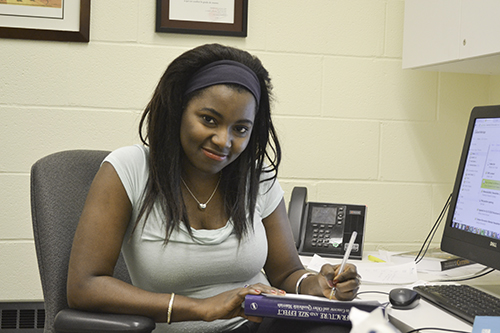
Ange-Therese Akono, Assistant Professor in Civil and Environmental Engineering
Ange-Therese Akono, an Assistant Professor in Civil and Environmental Engineering, is passionate about building innovative, strong, durable buildings. That’s why her research involves understanding the mechanical properties of materials used to construct them. Akono is also passionate about passing on her enthusiasm for materials to the next generation, particularly underserved students. So on January 18, 2016, Akono and eight of her graduate and undergraduate students hosted a Structural Mechanics Workshop for 28 juniors and seniors from Chicago’s Intrinsic High School.
Akono and company hoped to expose these inner city students to STEM activities they might not have previously gotten to experience:
“For now we’re kind of casting a broad net for students. We want them to come to a research one university and then get to understand what it is to do scientific research and to visit the laboratory and get to do hands-on experiments.”
The workshop involved having each student experience the concept of strength of materials on a wide range of materials commonly used in construction, then carry out experiments and analyze the results. The goal was for students to “develop scientific curiosities, scientific intuitions, and develop also kind of a taste for experimentation,” says Akono.
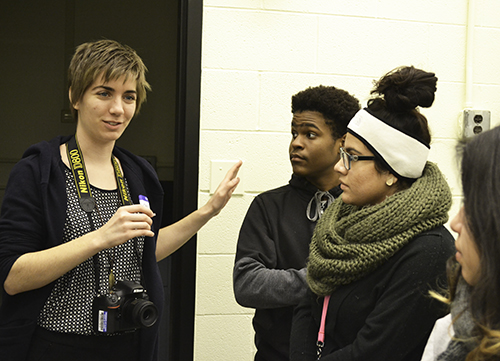
One of Akono's grad students (left) explains about the properties of a material used in construction to Intrinsic High students.
To make the activities even more fun and exciting for the students, Akono admits that there was evidently a little bit of demolition involved. “For this we’re just going to be breaking a lot of materials in the lab which is really fun, and I’m really excited about that.”
Besides exposing the Chicago youth to research being done in Akono’s Sustainability & Nanomechanics Lab, the day’s activities also involved brief presentations by Becky Stillwell, Civil Engineering’s Undergraduate Program Coordinator, and Engineering Associate Dean Liang Liu, to inform students about Illinois and answer any questions about the application process.
The workshop was a follow-up event to a webinar, during which Akono met remotely with the students as part of a class. During the 30-minute activity, she introduced the concepts of strength and durability of construction materials, demonstrated some experiments, then answered students’ questions. Based on the interest generated during the video time, the January workshop was then set up.
Akono acknowledges that she and her students hoped to pique the Intrinisic students’ interest in science and engineering: “We really want to spark this curiosity; we want to spark this interest, this scientific intuition. They are not necessarily expressing interest in science and technology and engineering. Our hope is to really kind of create even more interest about science and engineering.”
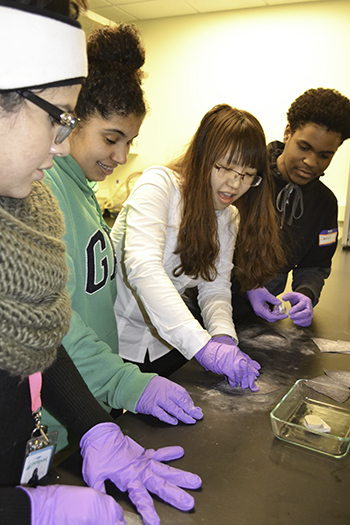
A Civil Engineering grad student (third from the left) shows the high school students how to work with a material they're testing.
Akono reached out to Intrinsic High, which is a new school (it's only been around for a couple of years) because it has a large population of Hispanic students. Akono and company ultimately want to empower students commonly underrepresented in STEM, to help them realize that they too can do it.
“I just want the kids to feel empowered," she admits. "I went to college, and then I went to grad school, and I feel that my education has empowered me so much, and I want every student to feel that—especially when it comes to minorities and underrepresented groups. I feel like the major obstacle most of the time is that they just don’t identify with the science, technology, and mathematics. They have this idea that, ‘This is a very super-complicated concept related to really, really smart people and not me!’”
Akono acknowledges that she and her students not only wanted the high schoolers to believe that they have what it takes to do STEM, but also to aspire to careers in STEM: “We want them to feel that those careers are accessible, and we want them to start thinking about it because next year they will be sending applications for college. It will require a lot of hard work, but they can access those careers in science, technology, engineering, and mathematics.”
Akono hopes that this year’s workshop is just the beginning of a long-term partnership with Intrinsic; she envisions sort of a pipeline into her lab, and into STEM…: “We really hope this isn’t going to be a one-time event, that it’s going to be an ongoing collaboration where we’re going to have a stream of students every year to come into our lab.”
Akono sees the opportunity for the high schoolers to interact not only with her, but with her graduate and undergraduate students as being invaluable.
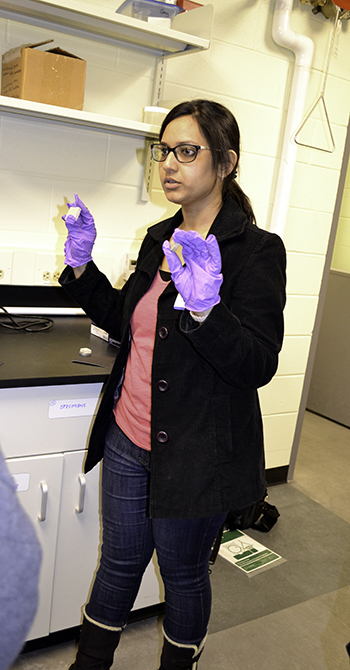
Amrita Kataruka, a PhD student in Structural Engineering, explains to the high school visitors the differences between two kinds of materials.
“This is really about transferring the knowledge. We are, in some sense, educating the next generation of civil engineers. And we’re starting to do it at a very small level where we have graduate and undergraduate students welcoming high school students that will be potential or prospective students in the years to come, and we’re already welcoming them to the lab right now.”
Akono isn’t the only one who hopes to recruit some of these students into Civil Engineering. Amrita Kataruka, a PhD student in structural engineering and member of Professor Akono's lab explains that she got involved in the outreach in order to recruit bright, young high school students into her field. She explains that since she’s been at Illinois, she’s discovered how important civil engineering is: “I’ve kind of understood why it’s necessary to actually have very learned, smart people who want to contribute to the society in this field of engineering. So, I think it would be a great thing if we can even motivate two or three of them to come into civil engineering and do great things.”
Jiaxin Chen, a first-year Master’s student in Civil also hopes to recruit some students into her field:
“I really like this activity because if we can motivate some kids to our university or other universities to study civil engineering—it’s really fun…I’m from China, and I really like civil engineering, and I traveled overseas to America to study. And, if I can let some children know about civil engineering and the meaning of doing the research or doing some civil engineering things, it’s really fantastic.”
How did the students do? “They’re pretty good,” reports Kataruka. “They’re enjoying it, and that was our main aim: to put civil engineering in front of them as a fun field, instead of a very, very technical field, and I think they’re liking it.”
“When I see their smile, it’s really fantastic.” Chen adds.
While Akono would also love to have the students to enter her field, she asserts that any engineering field would do:
“They don’t necessarily have to do civil engineering—they can go to mechanical engineering; they can go into aerospace engineering; they can go into another field of science or engineering and that would be awesome. That would be really great!”
Story and photographs by Elizabeth Innes, Communications Specialist, I-STEM Education Initiative.
More: Civil Engineering, Faculty Feature, Underserved Students/Minorities in STEM, Women in STEM, 2016
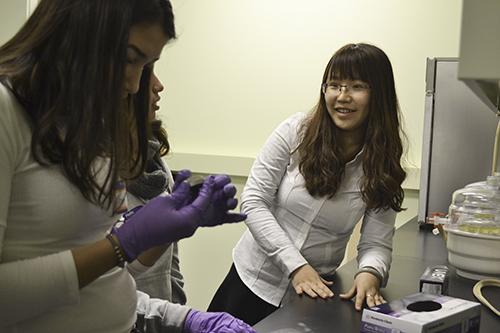
One of Akono's grad students (right), Jiaxin Chen, interacts with Intrinsic High students during a hands-on activity.
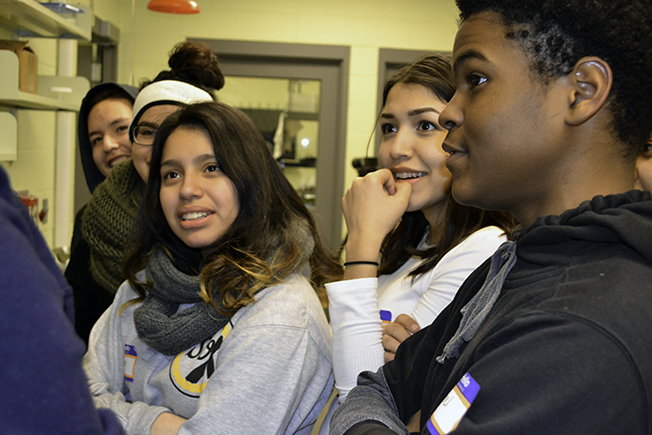
Intrinsic High students engage with an Illinois Civil Engineering student during the workshop.













.jpg)
















